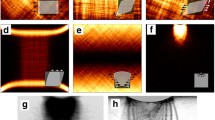Abstract
Nearly homogenous elastic shear on a molecular level rather than localized defect motion was considered to be the primary strain mechanism prior to yielding. The greatest or ideal value of the yield point for an amorphous polymer in the absence of the thermal activation was calculated. The theory involves a picture of the molecular motions under a shear stress involving three interconnected processes: 1. Shearons or intermolecular shear, 2. Rotons or intramolecular shear, 3. Tubons or motion along the covalent bond. The shear resistance was based on the stress to overcome the van der Waal's bond using a (6–12) potential. The model assumes that all atoms move co-operatively by the above motions, up to the point of yielding. Temperature was considered only as it affects the modulus, but the theory has not been extended to include thermal activation. The predicted value of shear yield point divided by shear modulus is <0.064 to 0.092; a review of all the experimental data obtained by extrapolations to 0 K gives an average value of 0.076±0.03.
Similar content being viewed by others
References
R. E. Robertson, J. Chem. Phys. 44 (1966) 3950.
I. V. Yannas and A. C. Lunn, Polym. Prepr. 16 (1975) 564.
A. S. Argon, Phil. Mag. 28 (1973) 839.
P. B. Bowden and R. Raha, ibid. 29 (1974) 149.
N. Brown, Bull. Amer. Phys. Soc. 16 (1971) 428.
S. H. Joseph, J. Poly., Sci. Phys. 16 (1978) 1071.
A. Kelly, “Strong Solids”, 2nd edn. (Clarendon Press, Oxford, 1973).
J. Frenkel, Z. Phys. 37 (1926) 572.
S. S. Brenner, J. App. Phys. 27 (1956) 1484.
A. S. Argon, “Glass Science and Technology” Vol. 5 (Academic Press, New York, 1980) Chap. 3.
J. K. Mackenzie, PhD thesis, University of Bristol (1949).
W. R. Tyson, Phil. Mag. 14 (1966) 925.
J. D. Bernal, Proc. Roy. Soc. (London) A280 (1964) 299.
H. H. Kausch and J. Becht, “Deformation and Fracture of High Polymers”, edited by H. H. Kausch, J. A. Hassel and R. J. Jaffee (Plenum Press, New-York, London, 1973) p. 317.
P. B. Bowden and J. A. Jukes, J. Mater. Sci. 7 (1972) 52.
P. B. Bowden and S. Raha, Phil. Mag. 22 (1970) 463.
J. P. Cavrot, J. Haussy, J. M. Lefebvre and B. Escaig, Mater. Sci. Eng. 36 (1978) 95.
C. Bauwens-Crowet, J. Mater. Sci. 8 (1973) 968.
J. Haussy, J. P. Cavrot, B. Escaig and J. M. Lefebvre, J. Poly. Sci. 18 (1980) 311.
P. Beardmore, Phil. Mag. 19 (1969) 389.
W. Wu and A. P. L. Turner, J. Poly. Sci-Phys. Ed. 13 (1975) 19.
J. R. Kastelic and E. Baer, J. Macromol. Sci-Phys. B7(4) (1973) 679.
C. Bauwens-Crowet, J. C. Bauwens and G. Holmes, J. Mater. Sci. 7 (1972) 176.
Y. Imai and N. Brown, Polymer 18 (1977) 298.
E. Kamei and N. Brown, Research in Progress, University of Pennsylvania (1982).
H. G. Olf and A. Peterlin, J. Poly, Sci. Phys. Ed. 12 (1974) 2209.
J. F. Rudd and E. F. Gurnee, J. Appl. Phys. 28 (1957) 1096.
R. J. Angelo, R. M. Ikeda and M. L. Wallach, Polymer 6 (1965) 141.
R. Buchdahl, Rev. Sci. Inst. 41 (1970) 1342.
W. G. Gall and N. G. McCrum, J. Polym. Sci. 50 (1961) 489.
A. F. Yee and M. T. Takemori, J. Poly. Sci-Phys. Ed. 20 (1982) 205.
K. H. Illers and H. Brever, Kolloid Z. 176 (1961) 110.
A. F. Yee and S. A. Smith, Macromolecules 14 (1981) 54.
K. H. Illers and H. Breuer, J. Colloid Sci. 18 (1963) 1.
N. G. McCrum, J. Polym. Sci. 60 (1962) 53.
K. H. Illers, Koltoid-Z Z. Polym. 231 (1969) 622.
H. A. Flocke, ibid. 180 (1962) 188.
E. Passaglia and G. M. Martin, J. Res. Nat. Bur. Stand. 68 (1964) 519.
I. G. Gilmour, A. Trainor and R. N. Haward, J. Poly, Sci-Phys. 12 (1974) 1939.
N. G. McCrum, B. E. Read and G. Williams, “Anelastic and Dielectric Effects in Polymeric Solids” (John Wiley and Sons, London, New York, 1967).
L. E. Nielsen, Trans. Soc. Rheol. 9 (1965) 243.
R. W. Warfield, J. Cuevas and F. R. Barnet, J. Appl. Polym. Sci. 12 (1968) 1147.
Author information
Authors and Affiliations
Rights and permissions
About this article
Cite this article
Brown, N. A theory of yielding of amorphous polymers at low temperature — a molecular viewpoint. J Mater Sci 18, 2241–2254 (1983). https://doi.org/10.1007/BF00541826
Received:
Accepted:
Issue Date:
DOI: https://doi.org/10.1007/BF00541826




